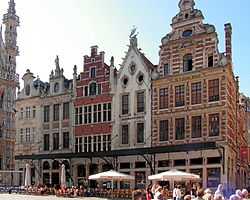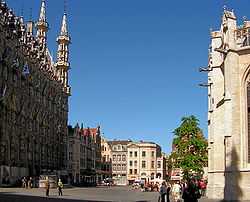Grote Markt (Leuven)


The Grote Markt ![]() listen (help·info) (Dutch for "Grand Square") of Leuven, Belgium is situated between the Oude Markt (Old Square) and the Rector De Somerplein (De Somer Square, named for Pieter De Somer, the first rector of the autonomous Dutch-speaking University of Leuven in 1968) and near both the Bondgenotenlaan (Avenue of the Allied Forces) and the Muntstraat (Mint Street).
listen (help·info) (Dutch for "Grand Square") of Leuven, Belgium is situated between the Oude Markt (Old Square) and the Rector De Somerplein (De Somer Square, named for Pieter De Somer, the first rector of the autonomous Dutch-speaking University of Leuven in 1968) and near both the Bondgenotenlaan (Avenue of the Allied Forces) and the Muntstraat (Mint Street).
Its location on the crossing of some of Leuven's most famous and most touristic spots makes the Grote Markt one of the city's busiest squares. However, it has been pedestrian-friendly for some years; only public transportation buses from De Lijn are allowed to use the square.
Buildings
This location is one of the oldest and most historic in all of Leuven. The square has existed in its present form since the 14th Century, when the Catholic University Leuven, or K.U.Leuven, was established. Most of the square's buildings are built in the Gothic style, of which the town hall is a prime example.
Other buildings on the Grote Markt are the Church of St. Peter and several guild houses. As throughout Leuven, there are also many pubs, taverns, and eateries on the Grote Markt. There is a significant contrast between the more formal and traditional style establishments on the Grote Markt and the more trendy, youth-oriented and student entertainment spots on the nearby Oude Markt.
Events
The Grote Markt is often used for cultural and other events, as is the case for Leuven's other big squares, such as the Oude Markt and the Ladeuzeplein (Ladeuze Square),
Flower Carpet
One yearly event is the transformation of the Grote Markt into one large carpet of flowers. Each year celebrates a particular theme, such as 2007's Bicentennial of the Leuven Fire Department.
In 2005, an administrative mistake caused the yearly flower carpet, completely made of begonias that year, to coincide with the opening and start of the local cycling contest, named after Jef Scherens. To avoid having the cyclists start their contest out of the middle of the carpet of flowers, Mayor Louis Tobback proposed a compromise: the cyclists would start their race from the outskirts of the square instead of the center and as compensation the theme of that year's flower carpet would be the Tribute to Cycling.
Summer Events
Being a university town, Leuven undergoes a drastic decrease in its usual population when thousands of students go home for the summer. For the last 20 odd years, the city of Leuven tries to compensate for the lack of students (along with their associated social activities) by organizing a number of summer events. Some of these taking place on the Grote Markt, among other spots in town, are:
- Beleuvenissen - weekly concerts on Friday nights in July, with themes such as salsa, tropical, jazz, blues.
- Hapje-Tapje (literally: a little snack - a small drink, approximately pronounced in English: hap-yeh, tap-yeh) - a gastronomical market during which participating restaurants set up stalls on the streets and squares of Leuven and offer small plates of their best food for a bargain price.
Planting of the Maypole
One of the oldest events is the planting of the Maypole which, in contrast with the British version, is not a pole as such but an actual tree, in Leuven usually a large birch tree. The origin of the Maypole celebration in Leuven is a century old dispute between the neighboring cities of Leuven and Brussels:
The tradition goes back seven centuries and according to the local folklore commemorates a victory of Brussels over Leuven, although others claim the origin was a wedding ceremony during which a nobleman from Leuven married a lower class girl from Brussels. The nobleman gave money to celebrate the patron saint of Lawrence of Rome and plant a Maypole in his honor.
Of course, the legend is told slightly differently in Brussels then in Leuven:[citation needed] One day in the year 1213 a wedding was held in a pub in Brussels. During the festivities, the guests noticed a gang of troublemakers from Leuven. A fight broke out and just when the wedding guests from Brussels were losing the fight, some members of the guild of St. Lawrence came to their rescue. The Leuven gang lost and John III, Duke of Brabant gave the guild members permission to plant a Maypole each year on August 9; but this privilege would be lost if ever the people of Leuven managed to capture the tree before 5 PM.
Coordinates: 50°52′45″N 4°42′05″E / 50.87917°N 4.70139°E